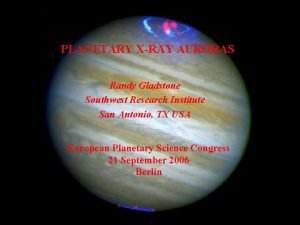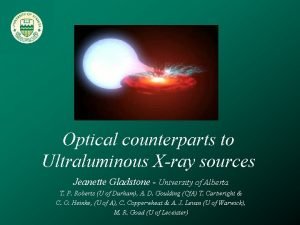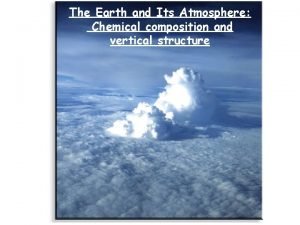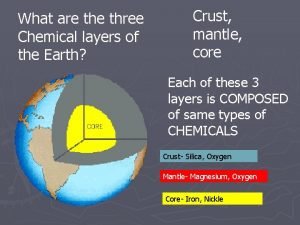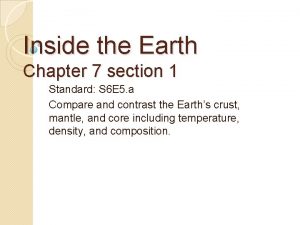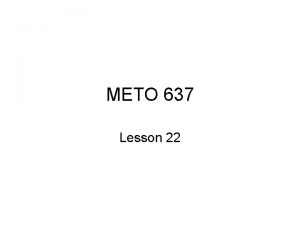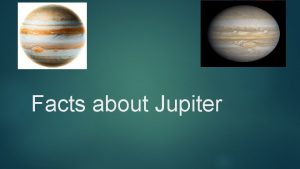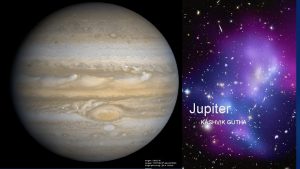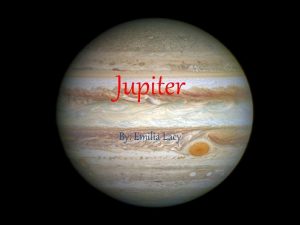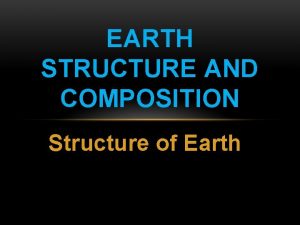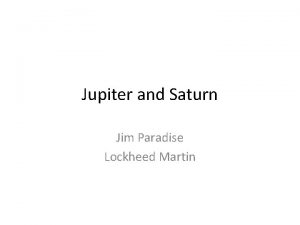JUPITER VERSUS THE EARTH COMPOSITION STRUCTURE Randy Gladstone









- Slides: 9

JUPITER VERSUS THE EARTH: COMPOSITION & STRUCTURE Randy Gladstone Southwest Research Institute, San Antonio TX 78238 NASA Space Science Workshop Explore! Jupiter’s Family Secrets May 4 -5, 2010 Springfield, MO

Solar System Architecture Warm Solar Nebula Temperature Rock Cold Ice + Rock Frost Line Pluto Neptune Ice Dwarf Uranus Saturn Mars Giant Planets Jupiter Sun Mercury Venus Earth Terrestrial Planets

How Do We Know What’s Inside a Planet? • For planets other than Earth, there are only a few ways to determine what’s inside • From the mean density (the total mass divided by the total volume) it is possible to constrain the internal structure based on models of likely composition • From the gravity field (determined by watching how satellites orbit) it is possible to tell more about how the mass inside a planet is distributed (e. g. , whether it has a core, etc. ) • For Earth, most of our knowledge of the interior come from the study of seismic waves (as are generated by large earthquakes)

Terrestrial Planet Interiors Venus (5250 kg/m 3) Mars (3940 kg/m 3) Earth (5520 kg/m 3) Mercury (5420 kg/m 3)

Earthquake Waves Probe Earth’s Interior

Inside Earth The major regions in the Earth are the crust, mantle, outer core, and inner core: • The outer crust is relatively thin (~30 km thick in the continents and ~5 km thick in the oceans) • The mantle is ~3000 km thick (almost halfway to the center of the Earth) and is made of a dense rock called peridotite; it has plastic-like properties and its slow overturning drags along the crust, causing plate tectonics (i. e. , continental drift) • The liquid outer core is 2300 km thick and is a mixture of iron (90%) and nickel (10%); motions in the liquid give rise to the Earth’s magnetic field • The solid inner core at Earth’s center has a 1200 km radius and is made of iron (90%) and nickel (10%); the temperature at the Earth’s core is ~5700 K and the pressure there is ~3. 6 million atmospheres

Earth Jupiter (1310 kg/m 3) Saturn Uranus Neptune (690 kg/m 3) (1190 kg/m 3) (1660 kg/m 3)

Jupiter Interior vs. Earth Interior

Inside Jupiter is still cooling off (and contracting) from its formation 4. 5 billion years ago (it emits 1. 7 times as much energy as it receives from the Sun)! • The atmosphere (the outermost ~5000 km at <1 atmosphere) is mostly molecular hydrogen and helium); heavier elements are generally enriched by ~3 times compared to the Sun • The deep atmosphere continues down another ~15000 km to a point where the pressure increases above a few million atmospheres and hydrogen becomes metallic; helium may be raining out near this boundary • The metallic hydrogen layer is ~50, 000 km thick and motions in the fluid give rise to Jupiter’s strong magnetic field • The rocky inner core at Jupiter’s center contains between zero and 20 Earth masses; the temperature at the Jupiter’s core is ~20, 000 K and the pressure there is ~40 million atmospheres
